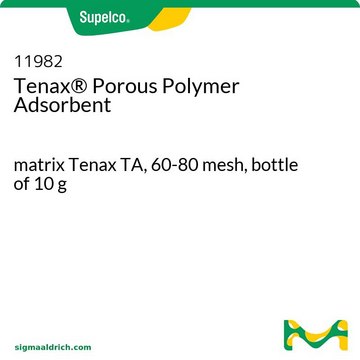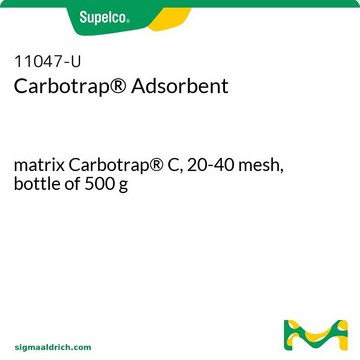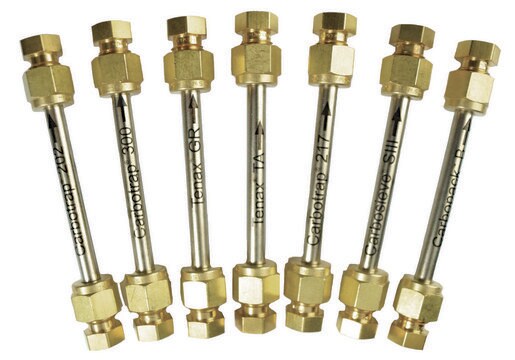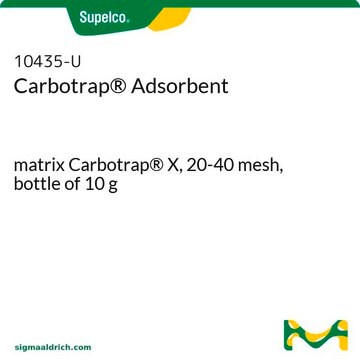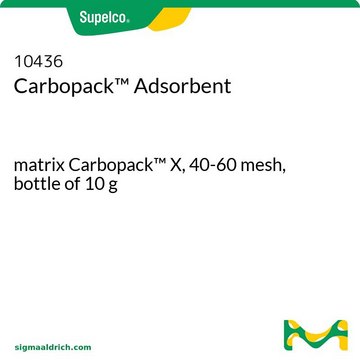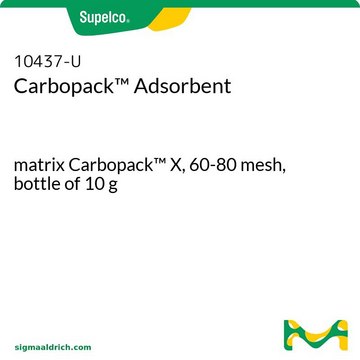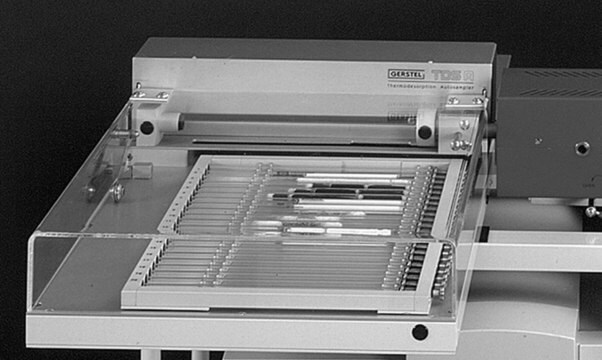추천 제품
제품 라인
Carbotrap®
Quality Level
양식
granular
포장
bottle of 10 g
기술
LPLC: suitable
표면적
~100 m2/g
Matrix
Carbotrap® B
기질 활성군
carbon
입자 크기
20-40 mesh
공극 크기
0 Å pore diameter
~0 cm3/g macroporosity
~0 cm3/g mesoporosity
~0 cm3/g microporosity
density
~0.38 g/mL (free fall density)
분리 기술
reversed phase
일반 설명
A graphitized carbon black (GCB) can be non-porous or porous. The graphitization process results in a highly pure surface with great adsorption and desorption (if required) properties. Surface interactions depend solely on dispersion (London) forces. These particles are:
Generally, GCB adsorbents offer weaker relative adsorptive strength compared to carbon molecular sieve (CMS) adsorbents, and similar relative adsorptive strength compared to spherical graphitized polymer carbon (SGPC) adsorbents. Our Carbotrap products are a type of GCB adsorbent.
For more information about any of our specialty carbon adsorbents, please visit sigma-aldrich.com/carbon
- Granular
- Friable
- Used for molecules with an analyte size relative to C3-C20+ n-alkanes
- Hydrophobic (can be used in high humidity environments)
Generally, GCB adsorbents offer weaker relative adsorptive strength compared to carbon molecular sieve (CMS) adsorbents, and similar relative adsorptive strength compared to spherical graphitized polymer carbon (SGPC) adsorbents. Our Carbotrap products are a type of GCB adsorbent.
- Particles are 20/40 mesh
- These large particles allow high flow rates without excessive pressure drops
For more information about any of our specialty carbon adsorbents, please visit sigma-aldrich.com/carbon
법적 정보
Carbotrap is a registered trademark of Merck KGaA, Darmstadt, Germany
적합한 제품을 찾을 수 없으신가요?
당사의 제품 선택기 도구.을(를) 시도해 보세요.
Storage Class Code
11 - Combustible Solids
WGK
nwg
Flash Point (°F)
Not applicable
Flash Point (°C)
Not applicable
개인 보호 장비
Eyeshields, Gloves, type P3 (EN 143) respirator cartridges
가장 최신 버전 중 하나를 선택하세요:
이미 열람한 고객
Plant Volatile Analysis.
Linskens HF and Jackson JF.
Modern Methods of Plant Analysis, 19, 54-56 (1997)
Florian Gahleitner et al.
Bioanalysis, 5(18), 2239-2247 (2013-09-24)
In-community non-invasive identification of asthma-specific volatile organic compounds (VOCs) in exhaled breath presents opportunities to characterize phenotypes, and monitor disease state and therapies. The feasibility of breath sampling with children and the preliminary identification of childhood asthma markers were studied.
Yifei Sun et al.
Journal of environmental sciences (China), 25(1), 213-219 (2013-04-17)
A group parameter approach using "total organic halogen" is effective for monitoring gaseous organic halogen compounds, including fluorine, chlorine, and bromine compounds, generated from combustion. We described the use of barrier-discharge radiofrequency-helium-plasma/atomic emission spectrometry, for the detection of semi- and
S Ghittori et al.
Journal of toxicology and environmental health, 38(3), 233-243 (1993-03-01)
Benzene concentrations in urine samples (Cu, ng/L) from 110 workers exposed to benzene in chemical plants and gasoline pumps were determined by injecting urine supernate into a gas chromatograph. The urine was saturated with anhydrous N2SO4 to facilitate the passage
W A McClenny et al.
Journal of chromatography. A, 813(1), 101-111 (1998-08-11)
An evaluation of performance criteria for US Environmental Protection Agency Compendium Method TO-17 for monitoring volatile organic compounds (VOCs) in air has been accomplished. The method is a solid adsorbent-based sampling and analytical procedure including performance criteria for four merit
자사의 과학자팀은 생명 과학, 재료 과학, 화학 합성, 크로마토그래피, 분석 및 기타 많은 영역을 포함한 모든 과학 분야에 경험이 있습니다..
고객지원팀으로 연락바랍니다.